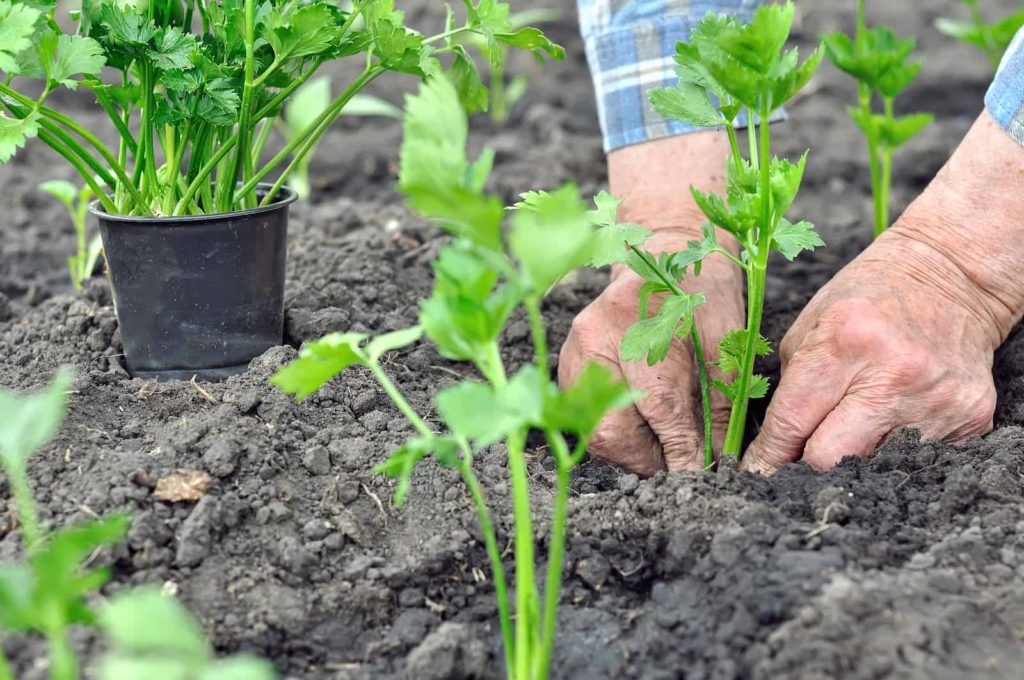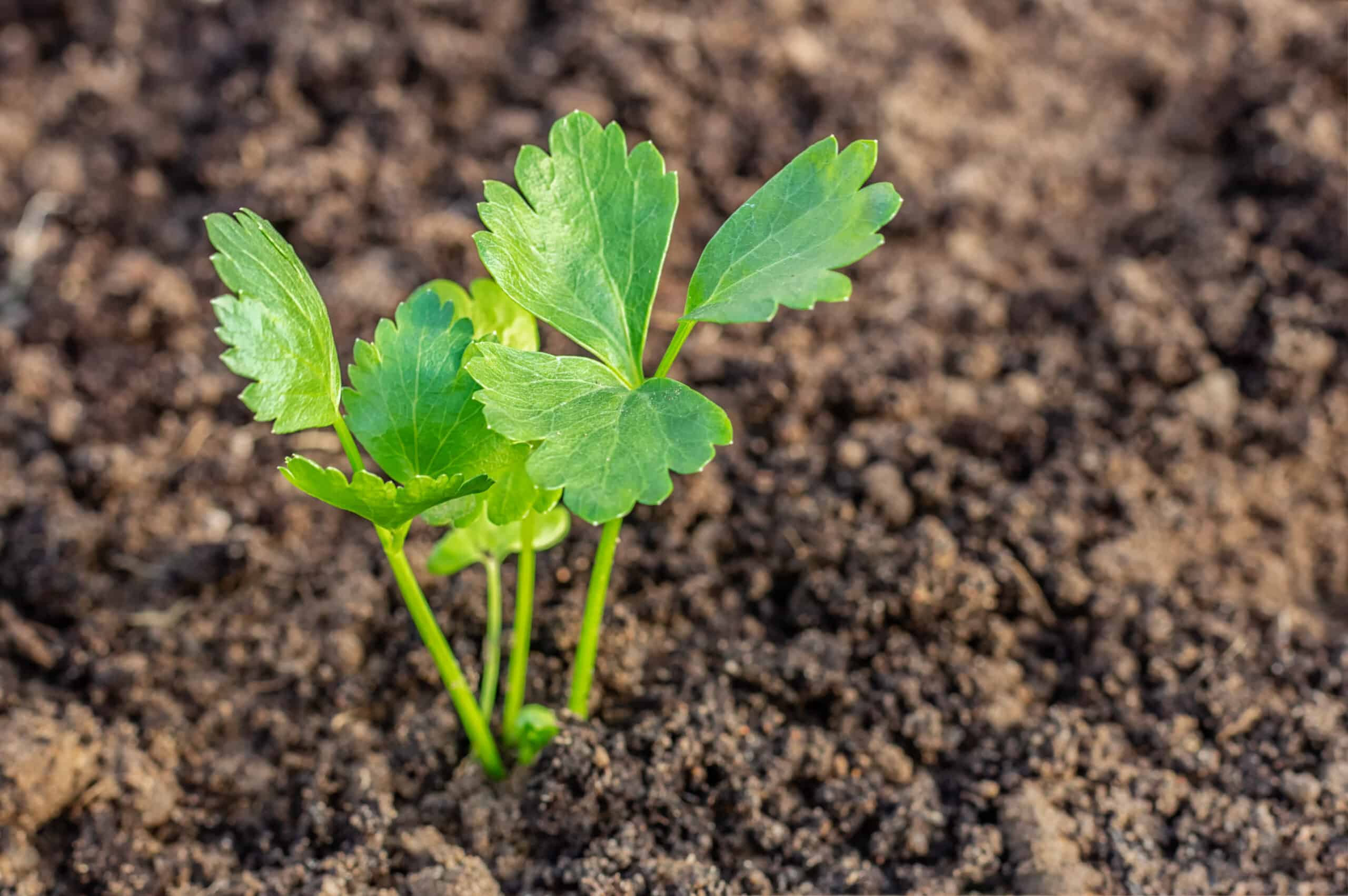Grow an early and late or main crop of celery each growing season. The early crop will be harvested in August; the late crop will be harvested in September or October, before the first fall frost.
Start celery seed indoors. Sow seed for the early or August harvest in February. Set young plants in the garden in May. Sow seed for the main crop or late harvest at the end of March or in April. Set young plants in the garden in June.
Celery grows best in cool weather, so the fall or main crop is often the best. For an early or summer harvest, plant a heat-resistant variety.
Celery seed germination
Celery seed takes about 21 days to germinate. Light helps celery seed germinate; do not plant the seed deeper than ¼ inch. Warm days and cooler nights, also help celery seeds germinate. Keep the soil evenly moist during the germination period.

Celery is a cool-season crop. It grows best where daytime temperatures are consistently greater than 55°F (13°C) but not consistently warmer than 80°F (26°C).
Where temperatures are very warm, celery will grow stringy; where temperatures fall below 50°F, celery will send up flower stalks and become bitter flavored.
Start celery indoors 14 to 6 weeks before the last expected frost in spring. Transplants can go in the garden two weeks before the last expected frost. Sow seed in midsummer 14 to 12 weeks before the first frost for an autumn harvest.
Celery matures in 98 to 130 days from seed sowing depending on the variety.

Celery planting details
- Sowing depth: ¼ inch (6mm) or less
- Space between plant after thinning: 6-8 inches (15-20cm)
- Days to sprout: 21
- Days to harvest: 100-140
- Storage period: 8-16 weeks
- Seeds per 100-row feet: ½ ounce (14 grams)
- Yield per 100-row feet: 200 plants
- Suggested varieties: Utah 50-70, Utah No. 15, Beacon, Spartan
Celery seedling transplanting
Celery plants form long taproots. If the taproot is broken, the plant will suffer. There are two ways to transplant celery into the garden and avoid injury to the taproot:
- Transplant the seedling early when it is just 3 to 5 inches (7-13cm) high, and before a taproot forms.
- Transplant the seedling twice: once indoors and secondly into the garden. Sow the seed in a flat; when the seedling is 3 to 5 inches (7-13cm) high, transplant it into an individual pot deep enough for a taproot to form, a pot 6 to 10 inches (15-25cm) deep. Grow the plant indoors. When the weather outdoors is warmer than 50°F (10°C), harden the plant off and then transplant it into the garden being careful not to disturb the taproot.
When transplanting celery to the garden, avoid chilling the plant below 50°F (10°C), or it may bolt to seed.
Celery growing conditions
Celery flavor is affected by growing conditions. Celery likes moist, light, rich soil that is well-drained. It does not like heavy clay, bog, or peat soil. Celery demands plenty of water, but it does not want wet feet.
Celery is a heavy feeder. Celery likes plenty of nitrogen. Add aged compost or well-rotted manure to the planting hole; you can also add bonemeal. Then give celery extra feedings about twice a month.
Celery sowing and planting tips
- Celery seed is viable for 5 years.
- Sow seed indoors 14 to 6 weeks before the last spring frost. Set out seedlings when they reach 3 inches (8 cm) tall about the time of the last frost.
- Sow seed ⅛ inch deep (3 mm).
- Celery seed will germinate in 10 days at 75°F (24°C); soak seeds overnight in water before sowing.
- Blanching celery varieties should be planted in a trench 12 inches (30 cm) deep by 18 inches (45 cm) wide. This will allow for stalks to be gathered and wrapped in wax paper and the trenches to be filled in about midseason; this is part of the blanching process.
- Self-blanching varieties do not require trenches or efforts to blanch the stalks.
- Harden plants by reducing water for 7 to 10 days before transplanting.
- Use row covers to keep plants warm for a month after transplanting if necessary.
- Space plants 6 to 8 inches (15-20 cm) apart in all directions.
- Add aged compost to planting beds in advance of sowing; compost will feed the soil and aide moisture retention.
- Celery grows best when daytime temperatures are in the 60s°
- Celery prefers a pH range of at least 5.8 to 6.8.
- Grow celery in full sun; celery tolerates partial shade.
- Avoid planting celery where carrots, dill, fennel, parsley, or parsnips have grown recently.
- Fertilize with an organic fertilizer such as fish emulsion at half strength.
- Common pests include aphids, cabbage loopers, celery worms, slugs, weevils, spider mites and whiteflies.
- Common diseases include blight, damping off, leaf spot, and celery mosaic.
Interplanting: Grow celery with beans, cabbage family plants, lettuce, spinach, and peas.
Container Growing Celery: Grow self-blanching varieties in a container at least 10-12 inches (25-30) wide and deep.
Celery planting calendar
Spring planting for spring and summer harvest:
- 10-12 weeks before the last frost in spring: start seed indoors.
- 2-3 weeks before the last frost in spring: transplant seedlings into the garden; minimum soil temperature should be 40°
- Sow seed indoors every 6 to 8 weeks for succession crops.
- 8 weeks after the last spring frost: transplant seedlings into the garden for autumn and winter harvest.
Celery seedling planting dates for summer harvest
(These dates are for the Northern Hemisphere)
| Average date of the last frost | Planting dates |
| Jan. 30 | Jan. 1-Feb. 1 |
| Feb. 8 | Jan. 10-Feb. 10 |
| Feb. 18 | Jan. 20-Feb. 20 |
| Feb. 28 | Feb. 1-Mar. 1 |
| Mar. 10 | Feb. 20-Mar. 20 |
| Mar. 20 | Mar. 1-Apr. 1 |
| Mar. 30 | Mar. 15-Apr. 15 |
| Apr. 10 | Apr. 1-Apr. 20 |
| Apr. 20 | Apr. 10-May 1 |
| Apr. 30 | Apr. 15-May 1 |
| May 10 | Apr. 20-June 15 |
| May 20 | May 10-June 15 |
| May 30 | May 20 -June 1 |
| June 10 | June 1-June 15 |

Recommended celery varieties
- ‘Conquistador’ is tolerant of temperature and moisture stress.
- ‘Ventura’ is disease tolerant and early to harvest.
- ‘Tango’ is an early variety.
Celery types: There are two types of celery: blanching and self-blanching. Blanching varieties require the exclusion of sunlight from their leaf stalks in order to blanch or turn white. Self-blanching varieties spontaneously lose the chlorophyll in their leaf stalks and do not require trenches for blanching.
Botanical Name: Apium graveolens var. dulce
Celery is a member of the Apiaceae also called the Umbelliferae family, other members of this family include carrots, dill, fennel, parsley, and parsnips.
Celery articles at Harvest to Table:
How to Harvest and Store Celery
Tasty Ways to Cook and Serve Celery
Celery Growing Problems Troubleshooting
Garden Planning Books at Amazon:
- Tomato Grower’s Answer Book
- Vegetable Garden Almanac & Planner
- Kitchen Garden Grower’s Guide Vegetable Encyclopedia
- Vegetable Garden Grower’s Guide



